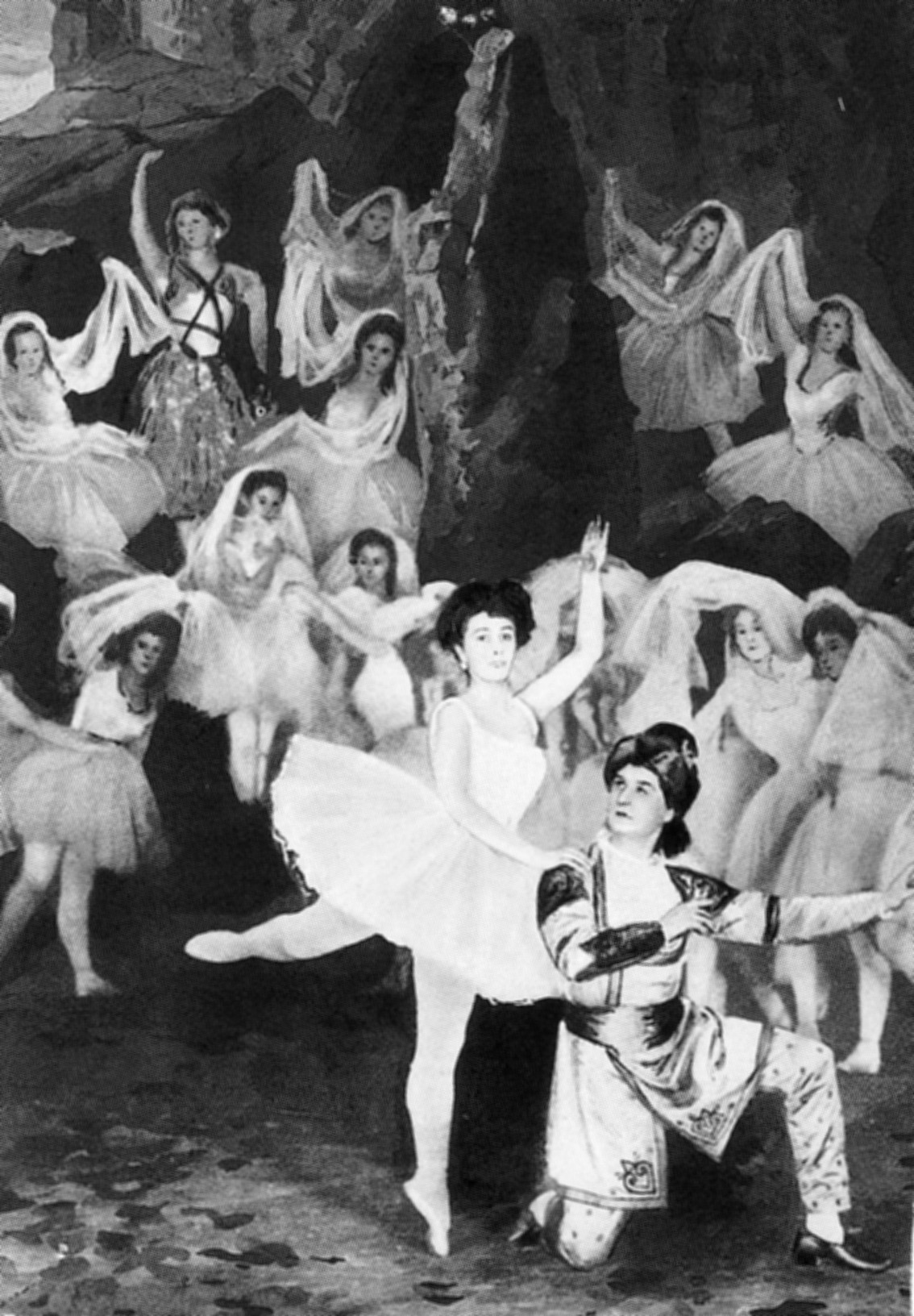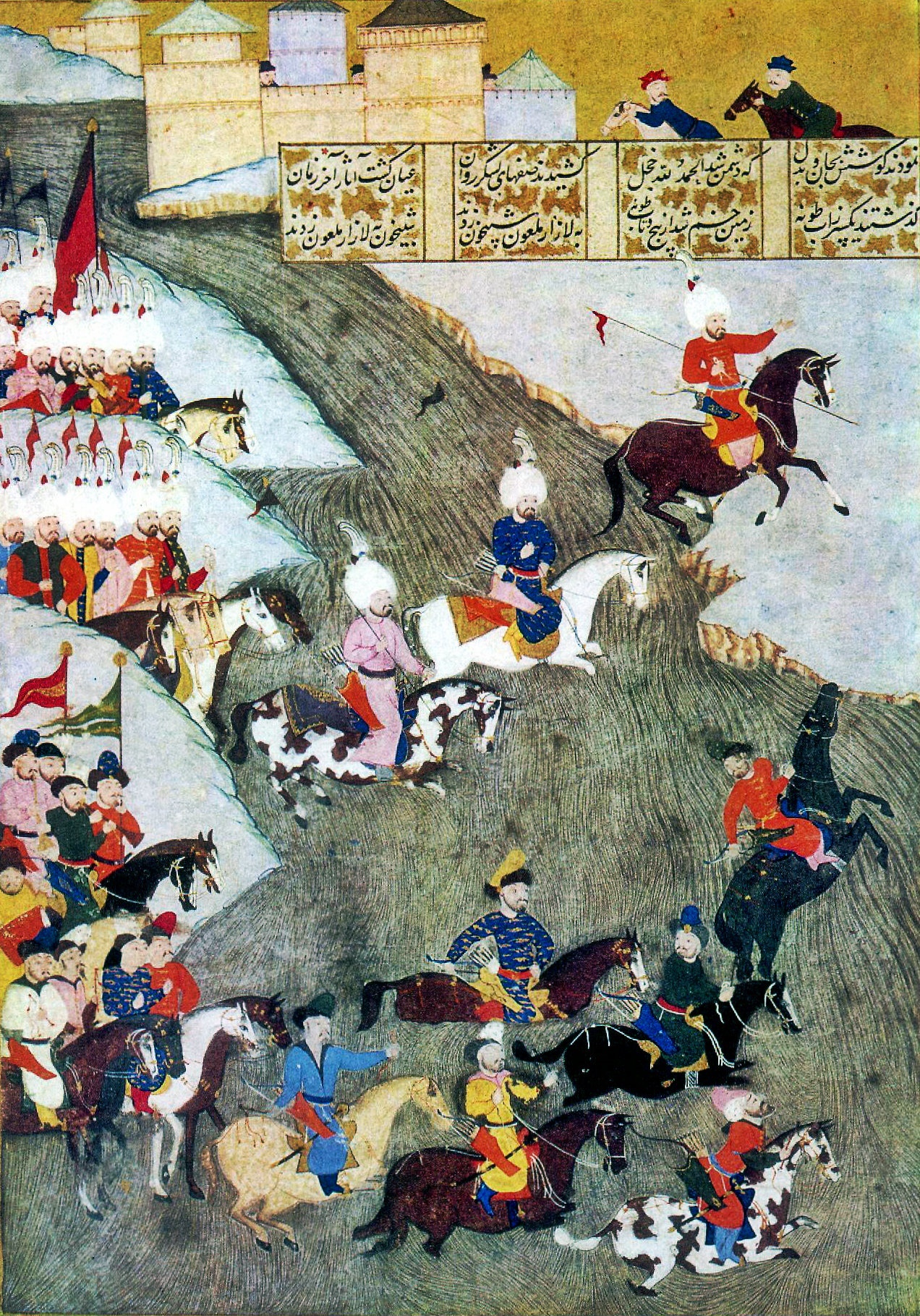|
Galiya Izmaylova
Galiya Bayazit gizi Izmaylova (12 February 1923, Tomsk – 2 October 2010, Tashkent) was an Uzbek and Soviet ballerina of Tatar origin, ballet master, choreographer, teacher, People's Artist of the USSR (1962), laureate of the Stalin Prize II degree (1950). Early life and education Galiya Izmaylova was born on 12 February 1923 in Tomsk in a Tatar family. Izmaylova's father was repressed when she was nine years old. She left Tomsk with her mother after her father's death and from 1931 lived in Tashkent. Izmaylova began her dance career at the age of 11, and soon she was invited to the newly opened ballet school. In 1935, Izmaylova entered the Uzbek Republican Ballet School. In 1941, she was in the first graduation of the students of the ballet school. After graduation she entered the troupe of the Uzbek Opera and Ballet Theater in Tashkent. Izmaylova was the leading prima ballerina, performing leading roles in the theater troupe. Career In 1943, Izmaylova danced her first par ... [...More Info...] [...Related Items...] OR: [Wikipedia] [Google] [Baidu] |
Tatars
The Tatars ()Tatar in the Collins English Dictionary is an umbrella term for different Turkic ethnic groups bearing the name "Tatar". Initially, the ethnonym ''Tatar'' possibly referred to the . That confederation was eventually incorporated into the when unified the various steppe tr ... [...More Info...] [...Related Items...] OR: [Wikipedia] [Google] [Baidu] |
Adolphe Adam
Adolphe Charles Adam (; 24 July 1803 – 3 May 1856) was a French composer, teacher and music critic. A prolific composer for the theatre, he is best known today for his ballets ''Giselle'' (1841) and '' Le corsaire'' (1856), his operas ''Le postillon de Lonjumeau'' (1836) and ''Si j'étais roi'' (1852) and his Christmas carol "Minuit, chrétiens!" (Midnight, Christians, 1844, known in English as "O Holy Night"). Adam was the son of a well-known composer and pianist, but his father did not wish him to pursue a musical career. Adam defied his father, and his many operas and ballets earned him a good living until he lost all his money in 1848 in a disastrous bid to open a new opera house in Paris in competition with the Opéra and Opéra-Comique. He recovered, and extended his activities to journalism and teaching. He was appointed as a professor at the Paris Conservatoire, France's principal music academy. Together with his older contemporary Daniel Auber and his teacher Adrien ... [...More Info...] [...Related Items...] OR: [Wikipedia] [Google] [Baidu] |
People's Artists Of Uzbekistan
People's, branded as ''People's Viennaline'' until May 2018, and legally ''Altenrhein Luftfahrt GmbH'', is an Austrian airline headquartered in Vienna. It operates scheduled and charter passenger flights mainly from its base at St. Gallen-Altenrhein Airport in Switzerland. History Founded as People's Viennaline in 2010, the first revenue flight of the company took place on 27 March 2011. For several years, People's only operated a single scheduled route between its homebase and Vienna. However, the route network has since been expanded with some seasonal and charter services. In November 2016, People's inaugurated the world's shortest international jet route (and, after St. Maarten-Anguilla, second shortest international route overall). The flight from St. Gallen-Altenrhein Airport, Switzerland, to Friedrichshafen Airport, Germany, took only eight minutes of flight over Lake Constance and could have been booked individually. The airline faced severe criticism for this service fr ... [...More Info...] [...Related Items...] OR: [Wikipedia] [Google] [Baidu] |
Soviet Ballet Dancers
This is a list of ballet dancers from the Russian Empire, Soviet Union, and Russian Federation, including both ethnic Russians and people of other ethnicities. This list includes as well those who were born in these three states but later emigrated, and those who were born elsewhere but immigrated to the country and performed there for a significant portion of their careers. The original purpose of the ballet in Russia was to entertain the royal court. The first ballet company was the Imperial School of Ballet in St. Petersburg in the 1740s. The Ballets Russes was a ballet company founded in the 1909 by Sergey Diaghilev, an enormously important figure in the Russian ballet scene. Diaghilev and his Ballets Russes' travels abroad profoundly influenced the development of dance worldwide. The headquarters of his ballet company was located in Paris, France. A protégé of Diaghilev, George Balanchine, founded the New York City Ballet Company. During the early 20th century, many Russi ... [...More Info...] [...Related Items...] OR: [Wikipedia] [Google] [Baidu] |
Tatar People
The Tatars ()Tatar in the Collins English Dictionary is an umbrella term for different Turkic ethnic groups bearing the name "Tatar". Initially, the ethnonym ''Tatar'' possibly referred to the . That confederation was eventually incorporated into the when unified the various steppe tr ... [...More Info...] [...Related Items...] OR: [Wikipedia] [Google] [Baidu] |
2010 Deaths
This is a list of deaths of notable people, organised by year. New deaths articles are added to their respective month (e.g., Deaths in ) and then linked here. 2022 2021 2020 2019 2018 2017 2016 2015 2014 2013 2012 2011 2010 2009 2008 2007 2006 2005 2004 2003 2002 2001 2000 1999 1998 1997 1996 1995 1994 1993 1992 1991 1990 1989 1988 1987 See also * Lists of deaths by day The following pages, corresponding to the Gregorian calendar, list the historical events, births, deaths, and holidays and observances of the specified day of the year: Footnotes See also * Leap year * List of calendars * List of non-standard ... * Deaths by year {{DEFAULTSORT:deaths by year ... [...More Info...] [...Related Items...] OR: [Wikipedia] [Google] [Baidu] |
1923 Births
Nineteen or 19 may refer to: * 19 (number), the natural number following 18 and preceding 20 * one of the years 19 BC, AD 19, 1919, 2019 Films * ''19'' (film), a 2001 Japanese film * ''Nineteen'' (film), a 1987 science fiction film Music * 19 (band), a Japanese pop music duo Albums * ''19'' (Adele album), 2008 * ''19'', a 2003 album by Alsou * ''19'', a 2006 album by Evan Yo * ''19'', a 2018 album by MHD * ''19'', one half of the double album ''63/19'' by Kool A.D. * ''Number Nineteen'', a 1971 album by American jazz pianist Mal Waldron * ''XIX'' (EP), a 2019 EP by 1the9 Songs * "19" (song), a 1985 song by British musician Paul Hardcastle. * "Nineteen", a song by Bad4Good from the 1992 album '' Refugee'' * "Nineteen", a song by Karma to Burn from the 2001 album ''Almost Heathen''. * "Nineteen" (song), a 2007 song by American singer Billy Ray Cyrus. * "Nineteen", a song by Tegan and Sara from the 2007 album '' The Con''. * "XIX" (song), a 2014 song by Slipk ... [...More Info...] [...Related Items...] OR: [Wikipedia] [Google] [Baidu] |
Order Of Lenin
The Order of Lenin (russian: Орден Ленина, Orden Lenina, ), named after the leader of the Russian October Revolution, was established by the Central Executive Committee on April 6, 1930. The order was the highest civilian decoration bestowed by the Soviet Union. The order was awarded to: * Civilians for outstanding services rendered to the State * Members of the armed forces for exemplary service * Those who promoted friendship and cooperation between people and in strengthening peace * Those with meritorious services to the Soviet state and society From 1944 to 1957, before the institution of a specific length of service medals, the Order of Lenin was also used to reward 25 years of conspicuous military service. Those who were awarded the titles "Hero of the Soviet Union" and " Hero of Socialist Labour" were also given the order as part of the award. It was also bestowed on cities, companies, factories, regions, military units, and ships. Various educational instituti ... [...More Info...] [...Related Items...] OR: [Wikipedia] [Google] [Baidu] |
Supreme Soviet Of The Uzbek SSR
The Supreme Soviet of the Uzbek SSR ( uz, Ўзбекистон ССР Олий Совети, Oʻzbekiston SSR Oliy Soveti; russian: Верховный Совет Узбекской ССР, Verkhovnyy Sovet Uzbekskoy SSR) was the supreme soviet (main legislative institution) of the Uzbek SSR from 1938 to 1991. The Supreme Soviet of the Uzbek SSR was preceded by the All-Uzbek Congress of Soviets which operated from 1925 to 1938. After the independence of Uzbekistan in 1991, the Supreme Soviet of the Uzbek SSR was briefly succeeded by the Supreme Council of the Republic of Uzbekistan from 1991 to 1994. The 1990 Uzbek Supreme Soviet election was the first and final supreme soviet election which allowed for multiparty elections. History The Supreme Soviet of the Uzbek SSR was established pursuant to constitutional reforms within the Uzbek SSR, which changed the organization of main political organs of the republic. In theory, the Supreme Soviet was to be a legislative body th ... [...More Info...] [...Related Items...] OR: [Wikipedia] [Google] [Baidu] |
Mukhtar Ashrafi
Mukhtar Ashrafi (russian: Мухтар Ашрафович Ашрафи, Uzbek: ''Muxtor Ashrafiy''; in Bukhara – 10 December 1975 in Tashkent) was a Soviet Uzbek composer. He was named People's Artist of the USSR in 1951. He became a member of the Communist Party of the Soviet Union in 1941 was awarded the Stalin Prize in 1943 and 1952. He is known as the author of the first Uzbek opera “Buran” (together with Sergei Vasilenko) and the first Uzbek symphony. His daughter Muqadamma was a noted medievalist. Early life and education Mukhtar Ashrafi was born on 29 May (11 June) 1912 in Bukhara. He grew up in the family of his father, a famous Bukhara singer and musician Ashrafzhan Hafiza. At the age of seven, Ashrafi began to play Uzbek folk instruments improvising on the dutar. In 1924, he entered Oriental Music School in Bukhara. In 1928, Ashrafi graduated a dutar class in Bukhara and entered the Samarkand Institute of Music and Choreography. From 1934 to 1936, he studied ... [...More Info...] [...Related Items...] OR: [Wikipedia] [Google] [Baidu] |
Aram Khachaturian
Aram Ilyich Khachaturian (; rus, Арам Ильич Хачатурян, , ɐˈram ɨˈlʲjitɕ xətɕɪtʊˈrʲan, Ru-Aram Ilyich Khachaturian.ogg; hy, Արամ Խաչատրյան, ''Aram Xačʿatryan''; 1 May 1978) was a Soviet and Armenian composer and conductor. He is considered one of the leading Soviet composers. Born and raised in Tbilisi, the multicultural capital of Georgia, Khachaturian moved to Moscow in 1921 following the Sovietization of the Caucasus. Without prior music training, he enrolled in the Gnessin Musical Institute, subsequently studying at the Moscow Conservatory in the class of Nikolai Myaskovsky, among others. His first major work, the Piano Concerto (1936), popularized his name within and outside the Soviet Union. It was followed by the Violin Concerto (1940) and the Cello Concerto (1946). His other significant compositions include the '' Masquerade Suite'' (1941), the Anthem of the Armenian SSR (1944), three symphonies (1935, 1943, 1947), and ar ... [...More Info...] [...Related Items...] OR: [Wikipedia] [Google] [Baidu] |




